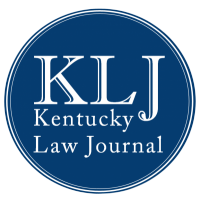Are Courts Inclined to Use a Natural Resource Law Doctrine to Regulate NFT Illegalities?
Blog Post | 111 KY. L. J. ONLINE | May 8 , 2023
Are Courts Inclined to Use a Natural Resource Law Doctrine (Public Trust Doctrine) to Regulate NFT Illegalities?
By: Dustyn W. Sams, Senior Staff Editor, Vol. 111
Where immense amounts of money lie, problems there will be–the story is no different with nonfungible tokens. Just like classic art, the NFT art craze is real.[1] Professionals value this market in the billions of dollars.[2] But one way the NFT market differs from classic art is that its newness makes it extremely volatile to illegalities like price gouging, money laundering, and tax evasion.[3] NFT ownership anonymity is a key contributor to these issues, which raises the question of how does one best regulate this art? One novel answer that a swath of academics might just cling to is the public trust doctrine, a legal principle deeply enshrined in natural resource law (not art regulatory law). Despite academics’ wide support of the doctrine’s general expansion, courts maintain the opposite position.[4] Courts, thus, would not extend the public trust doctrine to regulate NFT illegalities.[5]
The public trust doctrine is the legal principal that the government holds and manages land under navigable water and closely associated natural resources in trust of the people.[6] At the doctrine’s core is the broad idea that certain lands and natural resources, historically owned and controlled by states, are so closely tied to public rights and public interests that the states and federal government manage them for the public good.[7] This legal principal allows the government to closely monitor and limit certain human impositions on protected lands and relevant natural resources.
In 1970, Professor Joseph Sax published one of the most cited law review articles of all time, Liberating the Public Trust Doctrine From its Historical Shackles.[8] Sax argued that courts should liberate the doctrine’s reach, even to encompass “cultural treasures.” Many academics take the position of these remarks.[9] In the same vein, one could see how classic art and now, NFTs could constitute as cultural treasures. The analogy is that some art is valuable to the public in the same or a similar way that certain land and resources protected by the doctrine are valuable to the public. In fact, per In re City of Detroit, the United States Bankruptcy Court of the Eastern District of Michigan found “credible historical documentary evidence” that the City of Detroit holds the art inside the Detroit Institute of Arts (DIA) “in trust.”[10]
The only issue with this application is that the public trust doctrine is historically and overwhelmingly a doctrine courts apply only to land under navigable water, even popularly neglecting to go as far as applying it to natural resources.[11] NFTs are not a natural resource, and judges are not academics (professors and researchers). In a 2012 ranking for the most cited law review articles of all time, Sax’s 1970 article ranked forty-sixth.[12] State and federal courts, however, have only cited the article’s creed of liberation few dozen times.[13] This means that academia is primed for, and the courts are primed against, liberating the public trust doctrine.
Confusion riddles the doctrine with all sorts of fallacies. Many expansionists neglect the difference in the public trust doctrine and public trust values.[14] The difference is that the public trust doctrine imposes legal obligations on the government while public trust values place political obligations on the government.[15] The government’s political obligation is enforced by voters at the ballot box.[16] The government’s legal obligation is enforced by judges.[17] Many courts believe the doctrine’s liberation is better suited for the ballot box.[18] The confusion might derive from trust values in the nature of an NFT closely resembling characteristics of the public trust doctrine: they are commonly held by many people; their upkeep is tied to affecting the environment; and the intrinsic, public value of nature may be of a similar nature to the intrinsic, public value of NFT art. For example, one might uphold cultural treasures like certain NFTs to the same value as land and natural resource treasures. Although these values mirror some of the doctrine’s coverage areas, it does not change the fact that NFTs are not land under navigable water, nor natural resources. Such issues are better addressed by voters advocating to their legislators to pass relevant laws. Such would serve as a better regulator of the NFT market.
In conclusion, although litigants could make a decent argument that the public trust doctrine could regulate the NFT market and its accompanying illegalities, decent does not cut it. This is a doctrine – an Anglo-Saxon notion arguably derived from the depths of antiquity – so historically tied to land under navigable water and certain resources that protection of anything but such would not suffice in the eyes of most courts. This includes NFTs. It is true that illegality among the NFT market is a dire issue, but that is not one courts would take on by using the public trust doctrine. Perhaps the classic method of regulation by legislation or agency would fit the mold. That discussion requires more time and pages.
[1] Hiroko Tabuchi, NFTs Are Shaking Up the Art World, N.Y. Times (Apr. 13, 2021), https://www.nytimes.com/2021/04/13/climate/nft-climate-change.html.
[2] Brian Frye, The Illusory “Public Trust” in Art, SSRN 9 (2020), https://papers.ssrn.com/sol3/papers.cfm?abstract_id=3621761.
[3] E.g., James Field, EU Increases Focus on NFTs in Leaked Draft of Anti-Money Laundering Bill, CoinGeek (Mar. 7, 2023), https://coingeek.com/eu-increases-focus-on-nfts-in-leaked-draft-of-anti-money-laundering-bill/.
[4] James Huffman, Why Liberating the Public Trust Doctrine is Bad for the Public, 45 Env’t. L. 337, 339-40 (2015).
[5][5] Martin v. Waddel’s Lesse, 41 U.S. 367, 368-70 (1842); Richard J. Lazarus,
Changing Conceptions of Property and Sovereignty in Natural Resources: Questioning
the Public Trust Doctrine, 71 Iowa L. Rev. 631, 635 (1986); Allison Anna Tait, Publicity Rules for Public Trusts, 33 Cardozo Arts & Ent. L.J. 421 (2015).
[6] Waddel’s Lesse, 41 U.S. at 368-70; Lazarus, supra note 5, at 635; Tait, supra note 5, at 421.
[7] Lazarus, supra note 5.
[8] Joseph Sax, Liberating the Public Trust Doctrine from its Historical Shackles, 14 U.C. Davis L. Rev. 185 (1980).
[9] Brian Frye, Against Deaccessioning Rules, 53 Creighton L. Rev. 461, 478 (2020).
[10] In re City of Detroit, 524 B.R. 147, 177 (Bankr. E.D. Mich. 2014).
[11] Sax, supra note 8, at 475-85.
[12] Fred Shapiro & Michelle Pearse, The Most-Cited Law Review Articles of All Time, 110 Mich. L. Rev. 1483, 1490 (2012).
[13] Huffman, supra note 4, at 339-40.
[14] Huffman, supra note 4, at 364.
[15] Id.
[16] Id. at 364.
[17] Id. at 369.
[18] Id.

